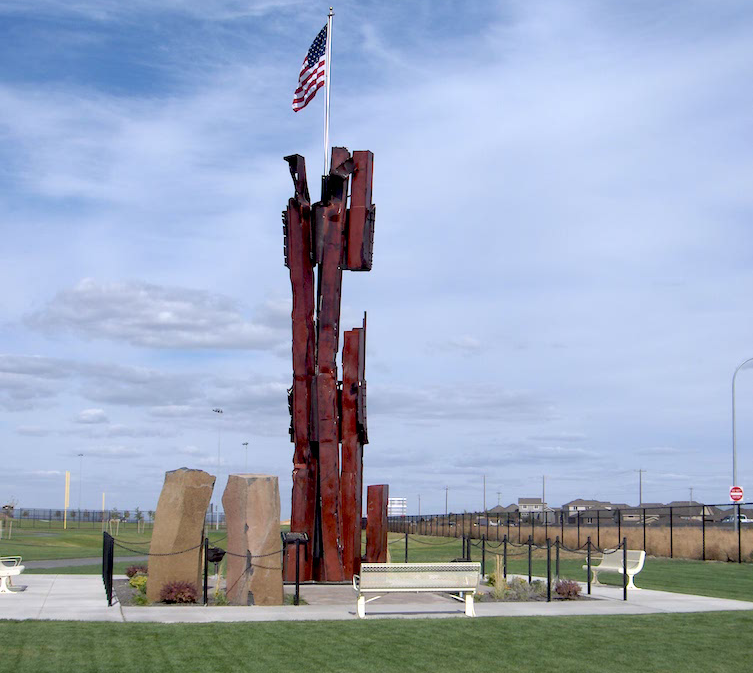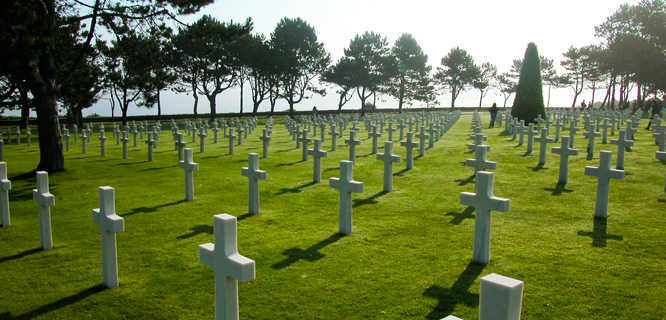Normandy American Cemetary © Rick Steves
9/11 and modern ruins as memorials to “innocents”
Lester Levine is a management consultant and writer living in Chapel Hill, North Carolina, USA. In 2003, he and his wife entered the competition to design the 9/11 memorial in New York as personal healing; they both knew people who were killed. Many years later, he learned that all 5,201 entries from 63 countries “lived” in an Internet archive and took a look. He became the first person to ever read every entry. The result was “9/11 Memorial Visions: Innovative Concepts from the 2003 World Trade Center Site Memorial Competition”, published in 2016. As issue 418 of L’Architecture d’Aujourd’hui focuses on ruins and vestiges, he gives his thoughts on how memorials relate to ruins.
To understand how a 9/11 memorial might relate to “ruins”, we need to consider a bit about the history of memorials for places of many deaths, mostly from war.
Deaths of soldiers are not unexpected. Memorials to these dead are most often marked on the exact places where they fought – fields, woods, beaches – like Ypres and Normandy in France, Leipzig in Germany, Fogliano Redipuglia in Italy, Volgograd (Stalingrad) in Russia and Gettysburg in the United States, often including cemeteries.
In contrast, memorials about the mass deaths of “innocents”, non-combatants going about their daily lives, have evolved differently. Only since World War II, have large numbers of civilians been deliberately targeted in modern warfare. Ruins of significant buildings near these events have become dramatic reminders of these deaths. The most well-known are the Coventry Cathedral (UK) and the Hiroshima Atomic Bomb Dome.
Coventry’s cathedral now stands ruined, bombed in the 1940 “Blitz” by the Luftwaffe. Similarly, in Berlin, the ruins of Kaiser Wilhelm Memorial Church, a victim of Allied bombing, remain.
The A-Bomb Dome was the building closest to the nuclear bomb hypocenter, amazingly left standing. It is located in what was once the city’s busiest downtown commercial and residential district, now called the Peace Memorial Park, to not only honor the victims, but also to establish the memory of nuclear horrors and advocate world peace.
Lesser known, but certainly as striking, are other WW II ruins in France, Germany and Russia. In France, they are the remainders of Oradour-sur-Glane, a village whose inhabitants were massacred and whose buildings were razed by the German army. Following the war, French president Charles De Gaulle declared it a “Village Martyr” where visitors are asked to remain silent until they have left.
Fast forward to 2001 and the events of 9/11, specifically in New York City. Over 2,500 innocents died there that day as the World Trade Center/”Twin Towers” were destroyed. In 2003, a worldwide competition was held to design a memorial to this event. There were over 5,000 entries from over 60 countries and 49 of the 50 US states. I am the only person who has ever read them, researching my book, “9/11 Memorial Visions”, published in 2016. As this attack centered on the iconic “Twin Towers”, the issue of ruins became prominent in imagining a memorial.
The remainders of the buildings were mentioned specifically in the call for designs to “convey historic authenticity…the memorial or its surrounding areas may include…surviving original elements…” Without question, the “element” most often featured in the entries was the repeated, complex filigree of the façade, most strikingly shown in the post-attack photos.
Can you imagine if this were the memorial today? It has been suggested, in some irony, that the design was inspired by Islamic Art which infuriated Osama Bin Laden, the attack’s planner.
Some proposed that the facade remains be the primary memorial feature. The most imaginative one, noted in my book, turned the element into a giant stained glass frame, creating dancing color across the site:
Many other entries preferred to use the single, core “fork-like” lower elements of the façade as stark reminders of the buildings within a multi-part design.
As it has turned out, the façade elements are not part of the memorial; rather, they are housed in the 9/11 Museum, historic artifacts rather than any implied representation of victims.
And the memorial centerpiece is not ruins per se, but rather the outlines of the buildings’ footprints, embodied as “voids”, evoking memories of the people now gone.
Interestingly, hundreds of steel tower remnants were saved and distributed. These have become most of the 1,100+ 9/11 memorials around the world:
They stand today as abstract ruins of 9/11. But without the façade context, might these uncomfortably suggest the death of buildings as much or more than those of people – especially 50 years from now? Time will tell.
Lester Levine, April 2017



